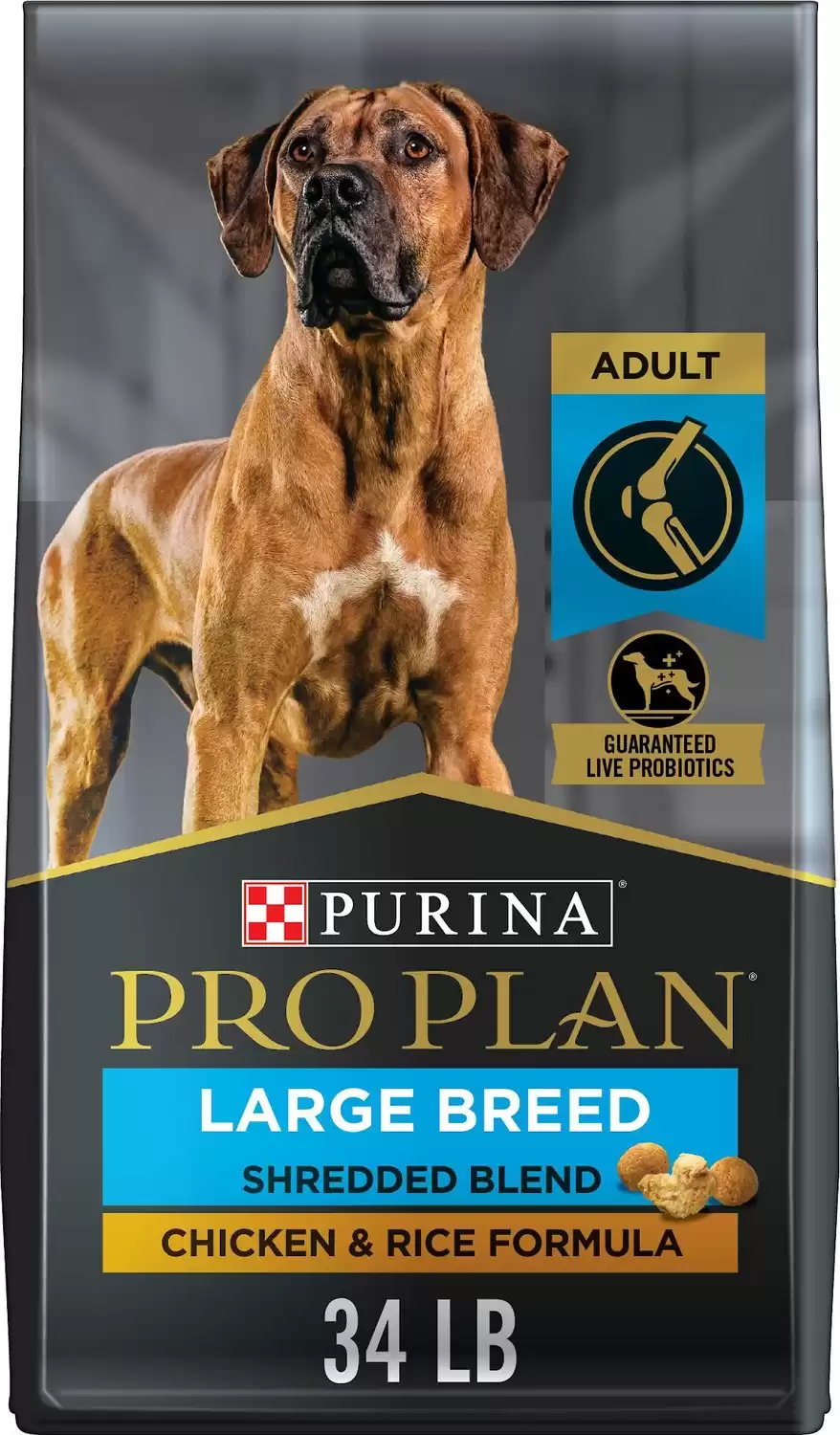Greater Swiss Mountain Dog
Canis lupus
They are closely related to the Bernese Mountain Dog.
Advertisement
Greater Swiss Mountain Dog Scientific Classification
- Kingdom
- Animalia
- Phylum
- Chordata
- Class
- Mammalia
- Order
- Carnivora
- Family
- Canidae
- Genus
- Canis
- Scientific Name
- Canis lupus
Read our Complete Guide to Classification of Animals.
Greater Swiss Mountain Dog Conservation Status
Greater Swiss Mountain Dog Facts
- Fun Fact
- They are closely related to the Bernese Mountain Dog.
- Diet
- Omnivore
- Common Name
- Greater Swiss Mountain Dog
Greater Swiss Mountain Dog as a Pet:
- General Health
- Energy Level
- Shedability
- Trainability
- Intelligence
- Tendency to Chew
- Size
- Family and kid friendliness
- Yappiness / Barking
- High
- Separation Anxiety
- Low
- Preferred Temperature
- Cold climate
- Exercise Needs
- Moderate
- Friendly With Other Dogs
- High
- Pure bred cost to own
- $1,500 to $2,300
- Dog group
- Working
- Male weight
- 105-140 lbs
- Female weight
- 85-110 lbs
This post may contain affiliate links to our partners like Chewy, Amazon, and others. Purchasing through these helps us further the A-Z Animals mission to educate about the world's species.
View all of the Greater Swiss Mountain Dog images!
Being a strong draft breed, the Greater Swiss Mountain Dog is powerful and large in size.
These dogs are covered in double coats, featuring an undercoat that is thick and an outer coat that is dense. The coat is about 1-1.5 inches long. The Greater Swiss Mountain Dog is incredibly animated, showing exactly how they feel in their facial expression and smile. Though it is easy to purchase a purebred puppy, many of these dogs are found in rescue shelters across the country.
See all of our expert product reviews.
History and Origin
The Greater Swiss Mountain Dog, as well as other Swiss breeds, most likely developed from the introduction of the Mollasian dogs, which were taken across parts of Europe by the Roman Legions. They may have already existed in some form before the Romans’ invasion, but that is unknown. Another line of thinking is that the Phoenicians carried with them a big dog breed to Spain around 1100 B.C. which might have moved westward towards the Swiss Alps.
This breed is the longest-lasting of the Swiss Sennehund dogs and helped pave way for the Rottweiler and St. Bernard breeds. They were known to have been utilized throughout central Europe by merchants and farmers for their great ability to pull loads for work. They were also used for simple tasks such as guarding. They were extremely popular in Switzerland until other means of transportation developed around the turn of the 20th century.
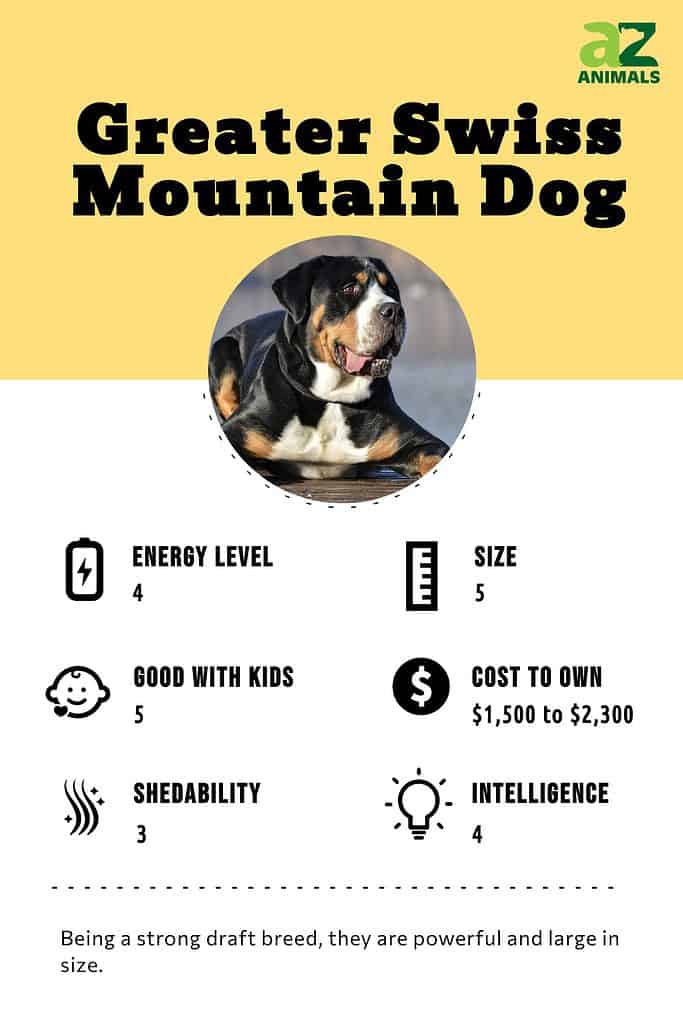
3 Pros and Cons of Ownership
Much like all other dogs and pets in general, the dog also has some pros and cons. When adopting this breed, consider the following pros and cons to decide if this dog would be a suitable match for you.
| Pros! | Cons! |
|---|---|
| Robust and powerful: This dog is robust and powerful. They are incredibly agile, which can make for a great defensive role in the household. | Huge build: Greater Swiss Mountain Dogs are huge in size. If you live in an apartment or a small home, this pup may require more space. |
| Easy-care coat: Despite the double coat of the Greater Swiss Mountain Dog, their grooming is relatively easy. They won’t require any intricate styling or brushing, though regular grooming is recommended to avoid excessive shedding. | Aggressive: Though loyal to their owners, these dogs are generally aggressive towards strangers or any animal that challenges them. |
| Vigilant watchdogs: Are you looking for a dog who can be the perfect watchdog for you? The Greater Swiss Mountain Dog is vigilant and smart, always looking out for danger. | Excessive barking: The Greater Swiss Mountain Dog barks a lot. If you want a small and quiet pet, this breed may not be the right option. |
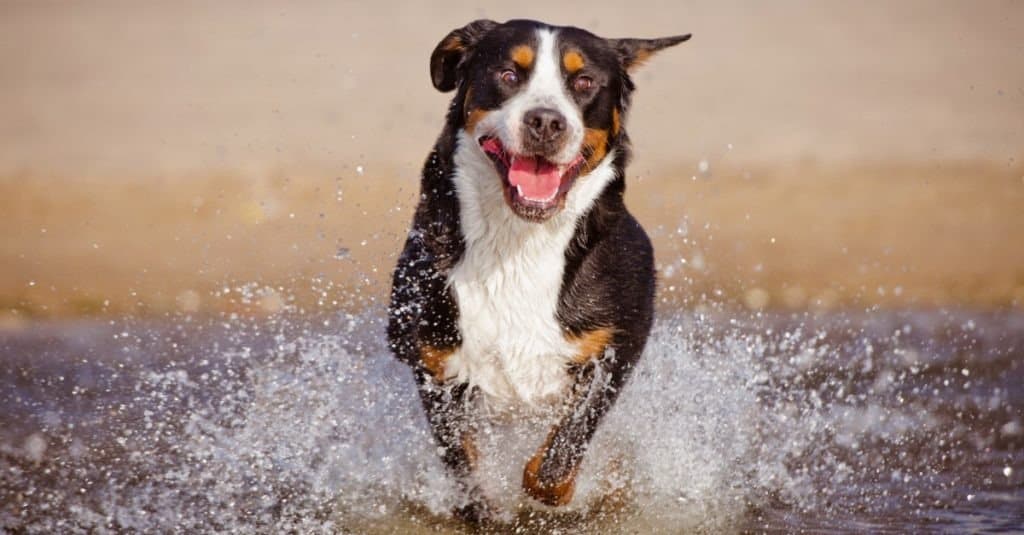
Though loyal to their owners, these dogs are generally aggressive towards strangers or any animal that challenges them.
©otsphoto/Shutterstock.com
Health and Entertainment for your Greater Swiss Mountain Dog
See all of our expert product reviews.
Size and Weight
These dogs are usually large and bulky. The female is usually 23.5 to 27 inches long, reaching a weight of anywhere from 85 to 110 pounds. Meanwhile, the males are a little larger, measuring about 25.5 to 28.5 inches in length and 105 to 140 pounds in weight.
| Height (Male) | 25.5 to 28.5 inches tall |
| Height (Female) | 23.5 to 27 inches tall |
| Weight (male) | 85 to 110 lbs., fully grown |
| Weight (female) | 105 to 140 lbs., fully grown |

Greater Swiss Mountain Dogs are usually large and bulky, topping out at 140 lbs.
©KIKKUZZO88 – Public Domain
Common Health Issues
These dogs are, like all other living creatures, prone to a number of health issues. Many of the health concerns associated with this dog are related to its large size, genetics, and other factors.
Perhaps one of the most common ailments of the dog is dysplasia in the hips and elbows. Dysplasia is the abnormal growth in these joints, which causes limping and pain. Their bones are at an elevated risk of damage, which is only proven by their predisposition to orthopedic problems like panosteitis and osteochondritis dissecans.
Panosteitis is also called Shifting Leg Lameness or Pano, and it happens spontaneously. This dog grows quickly, which is part of the reason that they have a higher risk. The dog will end up with inflammation in the long bones on the legs, which can prevent them from moving around. It can happen in dogs as young as two months old.
Osteochondritis dissecans have to be diagnosed with radiography, as it is nearly impossible to diagnose with symptoms. This condition essentially means that there’s improper development in the cartilage, and there’s the possibility of cracks and fissures. Some research suggests that breeders are trying to eliminate this condition from the breed’s genetic makeup.
Greater Swiss Mountain Dog can also suffer from eye diseases, gastric torsion (a twist in the gut), epilepsy (seizures in the brain), and urinary incontinence. Interestingly, female dogs are more prone to the latter than males.
Some of the problems that these dogs are prone to are:
- Hip Dysplasia
- Elbow Dysplasia
- Eye diseases
- Panosteitis
- Osteochondritis
- Gastric Torsion
- Epilepsy
- Urinary incontinence
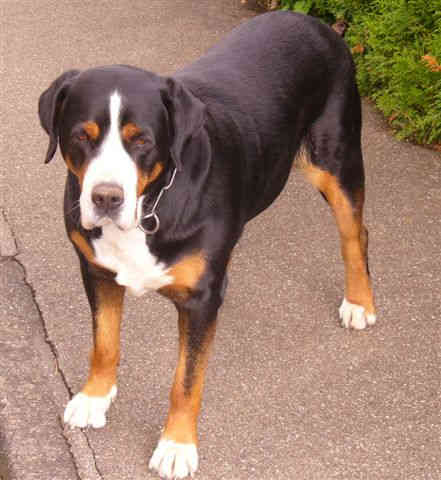
Many of the Greater Swiss Mountain Dog’s health concerns associated with this dog are related to its large size, genetics, and other factors.
©Norro – Public Domain
Temperament
These dogs, if properly trained, usually have a calm temperament. They are loyal and devoted to their owners’ families. However, maturity comes slowly to these dogs and therefore it can often be tiring to deal with a large-sized puppy. Another dog that has this slow maturation is the Saint Bernard.
When these dogs are small puppies, they are very active. However, sometimes, they can get very mouthy, tending to nip at little children when they run and chase them.
The Greater Swiss mountain dogs are usually eager to please. As long as they are not provoked, this breed is excellent with the children of the family, thanks to their sweet and easy-going nature. These dogs tend to be very cautious and protective of the home. Luckily, this astute attention to their surroundings allows them to show their courageous side as great watchdogs.

As long as they are not provoked, Greater Swiss Mountain Dogs are excellent with the children of the family, thanks to their sweet and easy-going nature.
How to Take Care of One
Before you get your hands on a Greater Swiss Mountain Dog (as a puppy or adult), you need to make sure that you are prepared for the task ahead of you. Here are a few things that you would want and need to keep in mind before adopting a Greater Swiss Mountain Dog as a pet.
The Best Dog Food
On a daily basis, the Greater Swiss Mountain Dog needs about four to five cups of high-quality dry dog food. Rather than allowing the pup to continually have access to food that they can graze on through the day, most experts advise dividing this into two separate meals for the dog.
Puppies are a different story. The puppies in this breed will need to have their food broken into 3 to 4 smaller meals in a day. The younger ones tend to have smaller stomachs, making smaller meals easier to digest.
A-Z Animals feels the best dog food for Greater Swiss Mountain Dogs is Purina Pro Plan Large Breed Adult Dry Dog Food Chicken with Shreds.
The high-protein formula is intended to nourish large dogs and their outsized nutritional needs. It’s made without artificial colors and flavors, so instead, you’ll find chicken, and beef ingredients, plus fish, a source of glucosamine for stable joints. You’ll also be relieved to find calcium phosphate to build and maintain strong bones. The rice adds natural fiber to the probiotics for easy digestion.
Check Chewy or Amazon for this product.
- Crunchy kibble combined with tender, shredded pieces for taste and texture dogs love
- High protein formula, with real chicken as the first ingredient
- Fortified with guaranteed live probiotics for digestive and immune health
- Used to be known as SAVOR Shredded Blend Large Breed Formula
- Glucosamine and EPA, an omega-3 fatty acid, for joint health and mobility
Maintenance and Grooming
These dogs have double coats – one is thick, and one is dense. Brush it weekly to remove dead coat hair, but this brushing is rather easy and relaxing for you and your dog alike.
While these dogs do not drool as other breeds do, they shed a lot. In fact, they have so much fur that they shedding heavily during spring and fall months is fairly common, even with the more moderate temperatures. A shedding blade is incredibly useful to keep on hand (if you intend to do the grooming yourself).
Nail care is equally important. This dog’s nails can grow quickly, so you should trim their nails every week or two. Teeth should be brushed daily to maintain the health of the mouth and to prevent decay. Many products on the market make this part of their care easy, like treats that break down plaque.
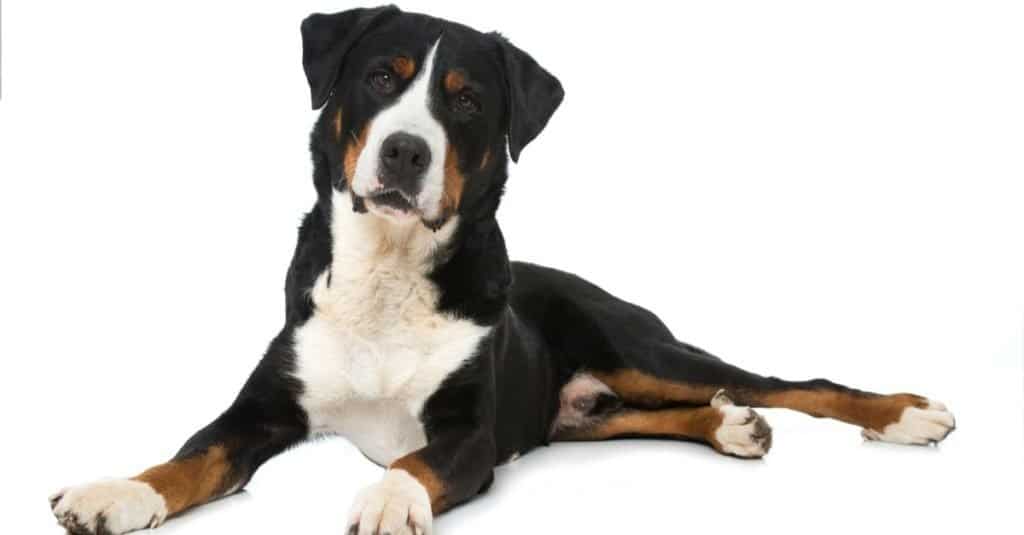
Greater Swiss Mountain Dogs have so much fur that shedding heavily during spring and fall months is fairly common, even with the more moderate temperatures.
©Dora Zett/Shutterstock.com
Training
While you can’t keep pushing your dog to train, these dogs shouldn’t be too resistant to it. They are willing to learn for the sake of pleasing their owner, so the best approach will be a training routine that comes with plenty of praise and positive reinforcement. This training will mean the difference between a disruptive dog and a housebroken, obedient dog.

Greater Swiss Mountain Dogs are willing to learn for the sake of pleasing their owner.
©Kikko88 – Public Domain
Exercise
These dogs require a moderate amount of exercise each day, so a home with a yard is their best friend. Even with outdoor exposure, it is best to bring this dog out on a long walk once or twice a day to get its body moving. Exercise is also an excellent way to reduce the risk of obesity, which can occur in dogs that don’t get enough physical activity or balance in their diet.
Puppies
Bringing up and taking care of a puppy is similar to that taking care of an adult. However, instead of two large meals, you would need to break their meals into at least three to four smaller meals so that the puppies could adjust easily and digest the food properly in their smaller stomachs.
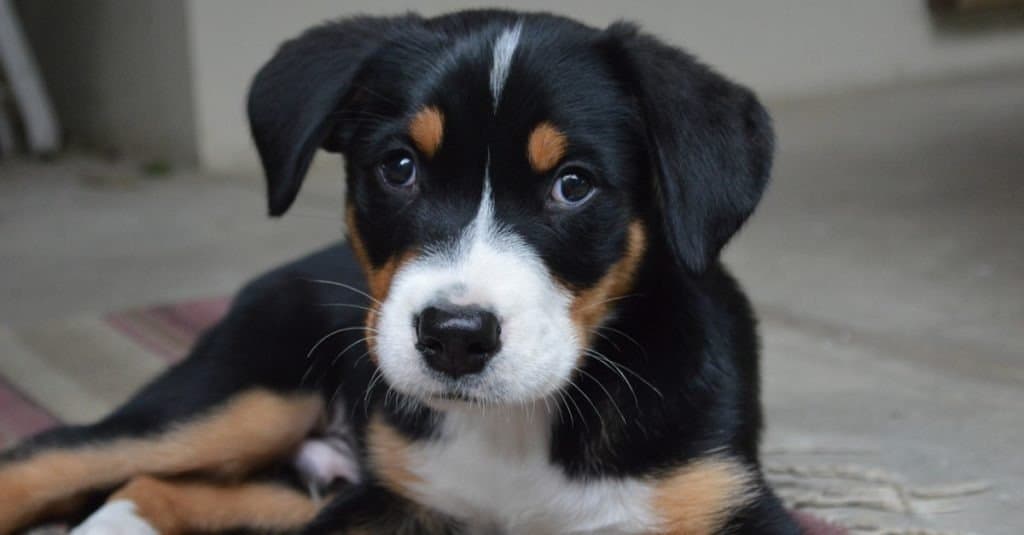
Greater Swiss Mountain Dogs are great around children, maintaining a friendly personality that is devoted and loving towards their companions.
©hc1225/Shutterstock.com
With Children
These dogs are great around children, maintaining a friendly personality that is devoted and loving towards their companions. They make great playmates, and they naturally take on the role of a careful and vigilant watchdog around the family. They will be highly cautious of newcomers in the home, protecting their loved ones as needed. With the right training, this pup would be proud to defend its home.

Greater Swiss Mountain Dogs are extremely cautious of newcomers in the home, protecting their loved ones as needed.
©Anze Urbanija/Shutterstock.com
Similar Dogs
Here are some dogs that are similar to these dogs:
- Bernese mountain dogs: These dogs are much like the Greater Swiss Mountain Dog, and they are even mistaken for the same breed (on occasion). However, they have thicker coats and require much more grooming. They are also known to shed more.
- Appenzeller Sennenhund: These dogs are very energetic and serve as rescue dogs who show the way to lost travelers and rescue them.
- Entlebucher Mountain Dogs: These dogs are also very closely related to the Bernese mountain dogs. They are alert and are often known as “laughing dogs.”
Famous Examples
Several famous celebrities own these dogs, like Sarah Michelle Gellar (of the Buffy the Vampire Slayer franchise and the Scooby Doo films).
These dogs have also been featured in a YouTube film called Pearl.
Popular Names
Here are some of the popular names for these dogs:
- Moose
- Bear
- Bella
- Charlie
- Luna
Greater Swiss Mountain Dog FAQs (Frequently Asked Questions)
Are Greater Swiss Mountain Dogs herbivores, carnivores, or omnivores?
Greater Swiss Mountain Dogs are Omnivores, meaning they eat both plants and other animals.
What Kingdom do Greater Swiss Mountain Dogs belong to?
Greater Swiss Mountain Dogs belong to the Kingdom Animalia.
What class do Greater Swiss Mountain Dogs belong to?
Greater Swiss Mountain Dogs belong to the class Mammalia.
What phylum to Greater Swiss Mountain Dogs belong to?
Greater Swiss Mountain Dogs belong to the phylum Chordata.
What family do Greater Swiss Mountain Dogs belong to?
Greater Swiss Mountain Dogs belong to the family Canidae.
What order do Greater Swiss Mountain Dogs belong to?
Greater Swiss Mountain Dogs belong to the order Carnivora.
What type of covering do Greater Swiss Mountain Dogs have?
Greater Swiss Mountain Dogs are covered in Hair.
What genus do Greater Swiss Mountain Dogs belong to?
Greater Swiss Mountain Dogs belong to the genus Canis.
What is an interesting fact about Greater Swiss Mountain Dogs?
Greater Swiss Mountain Dogs are protective and gentle by nature!
How much does Greater Swiss mountain dog cost to own?
They cost around $1,500 to $2,300. You could expect an additional price of about $2,000 annually to keep up with its maintenance and grooming.
Is Greater Swiss mountain dog good with kids?
Yes, these dogs are great with kids. They make good playmates and vigilant watchdogs.
How long does the Greater Swiss mountain dog live?
The Greater Swiss mountain dogs usually live for about 10 to 11 years.
What is the difference between a Greater Swiss Mountain Dog and a Bernese Mountain Dog?
The Bernese mountain dog has a thicker coat than the Greater Swiss mountain dog and requires more grooming. Bernese mountain dogs also shed more than Greater Swiss mountain dogs.
Are Greater Swiss Mountain Dogs good pets?
They are friendly and very devoted to the owner’s families and make good family pets.
Do Greater Swiss Mountain Dogs shed a lot?
The shed heavily during the Spring and fall season.
How much does a Greater Swiss Mountain Dog puppy cost?
The price would be somewhere around $1500 to $2300.
What is the scientific name for the Greater Swiss Mountain Dog?
The scientific name for the Greater Swiss Mountain Dog is Canis lupus.
Thank you for reading! Have some feedback for us? Contact the AZ Animals editorial team.
Sources
- Petfinder, Available here: https://www.petfinder.com/dog-breeds/greater-swiss-mountain-dog/
- Your Pure Bred Puppy, Available here: https://www.yourpurebredpuppy.com/reviews/greaterswissmountaindogs.html
- Dogtime, Available here: https://dogtime.com/dog-breeds/greater-swiss-mountain-dog#/slide/1
- Vetstreet, Available here: http://www.vetstreet.com/dogs/greater-swiss-mountain-dog
- Dog Breed Info, Available here: https://www.dogbreedinfo.com/greaterswissmountain.htm
- Cornerstone Greater Swiss Mountain Dogs, Available here: https://www.cornerstonegsmd.com/------------------------the-beginner-s-guide-to-the-greater-swiss-mountain-dog.html
- Pet ID Register, Available here: https://petidregister.com/greater-swiss-mountain-dog/are-greater-swiss-mountain-dog-good-with-kids/





